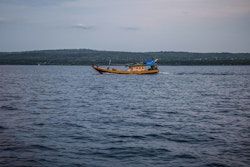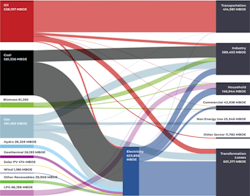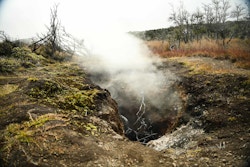Indonesia: an energy mix not too coal
On the crossroads of the Indian and Pacific oceans, located off the coast of mainland Southeast Asia, stands Indonesia: the largest archipelago in the world. Energy Observer has been sailing in Indonesia since the beginning of 2022, from Jakarta to Bali and a few other stops before heading to Singapore, our main stopover in Asia. Beatrice Cordiano, our energy and sustainability expert is on board our vessel and gives us an overview of the energy transition landscape, mainly relying on coal today.
Formerly known as the Dutch East Indies, the territory was -as its name suggests- a colony of Netherlands. Its current name, which derives from the Greek words Indos (Indian) and nesos (islands), came into use after 1880 and became official only at the time of its independence declaration, after a period of Japanese occupation during World War II.
This vast archipelago made of more than 17,500 islands -among which the biggest are Sumatra, Java, Kalimantan, Sulawesi and Papua- lies across the Equator spanning 5150 km west to east, namely a distance equivalent to one-eight of Earth’s circumference, and for centuries it represented a bridge between Oceania and mainland Asia’s people and cultures.

Kupang, Indonesia
The Indonesian territory covers one of the most unusual regions in the world: being located on the Ring of Fire, where multiple tectonic plates (Pacific plate, Australien, Eurasian and other plates) meet, and sometimes slide one under the other, it is home to frequent volcanic and seismic activities.
With an estimated population of 270 million people, it is the fourth most populous country in the world. Nevertheless, it presents many huge isolated wild areas that, thanks to a favourable tropical climate, host a rich biodiversity which combines the flora and fauna realms of Asia and Australasia.
With its densely forested mountains whose slopes turn into coastal swampy plains, Indonesia ranks second only to Australia for quantity of endemic species: 36% of its birds and 39% of its mammals are endemic. But land is not the only place holding such a diverse wildlife, its tropical seas do it too. Being situated in the Coral Triangle, its coral reefs and marine ecosystems teem with an incredible varied biodiversity.
A thirst for energy
In the last 20 years Indonesia has known a rapid demographic growth and a quick industrialization. Its population has risen by 30%, rising from 211.5 million people back in 2000 to 273.5 in 2020, and it is expected to continue to grow more in the years to come. This means that the country demand for energy, that has already increased by 80% since 2000, will literally soar - which would not be a problem per se, except that the current energy mix of the country is far from being sustainable.

Energy consumption by source, Indonesia
Indonesia primary energy consumption is today very close to France’s one: in 2019 the South-Asian archipelago consumed 2475 TWh (France consumed 2689 TWh in that same year). Energy is not just electricity, it includes transport and heating too. Looking at electricity consumption alone, Indonesia required 281 TWh in 2019 (565 TWh for France), an even wider gap with respect to that of energy.
Considering the difference in size and population of these two countries, we can say that an average Indonesian person consumes far less energy than a person in France: according to the estimates we talk about around 4,5 times less energy and around 8 times less electricity. Here you will wonder where the problem lies for Indonesia since it is way bigger, and it consumes way less. In fact, these numbers are good to depict the nation’s energy needs but they are not very representative of how sustainable the energy sector is.
To get that feeling, we need to look at what is called carbon intensity, namely the quantity of carbon dioxide that it takes to produce a kWh of energy. Indonesia’s carbon intensity is 0,27 kg/kWh: more than twice that of France. How come?
Coal: a booster and a limit for Indonesia’s power industry
Indonesia owns 3.2% of world coal reserves -whose majority is mainly located in East Kalimantan and South Sumatra- and with 560 million tons extracted in 2020, it is the third largest producer and the second exporter worldwide. Coal is big business in Indonesia, it is a cheap source of energy to support the economic growth. This partially explains the fact that the country still highly relies on fossil fuels: in 2019 up to 94% of the energy consumed came from fossil fuels (38% from coal, 38% from oil, 18% from natural gas). In that same year, almost 60% of electricity was produced from coal.
As you may remember, during the COP26 days, coal created a lot of debate. It is, in fact, the most polluting source of energy : 1001 gCO2eq are emitted for each kWh of electricity produced. As a reference, to produce 1 kWh of energy, 469 gCO2eq are produced with natural gas, 48 if using photovoltaic panels, 4 via hydropower, 12 with onshore wind turbines. This makes Indonesia fall in the list of the most polluting countries in the world.

Indonesia primary energy supply and final energy consumption 2019
Preparing a greener future
Despite the current power industry set-up -or perhaps precisely because of it- the government has declared its willingness to shift away from fossil fuels and reach net zero carbon emissions by 2060. In accordance with the pledge that has been signed at COP26 climate summit to phase out coal-fired power plants by 2040, Indonesia is planning to decommission a quarter of its total generating coal capacity of 9.2 GW by 2030 with international financial assistance, avoiding emitting 89 million tons of GHGs per year.
In its greening policy, the government is committed to bring the share of clean primary energy to 23% by 2025 and 31% by 2050. An objective far beyond the current state of play if we consider that in the 2019 primary energy mix renewables accounted for only 6,1%, biofuels and hydro being the major contributors and making 2,7% and 1,7% of the total share respectively.
Low carbon sources are not that popular, yet Indonesia possess a huge renewable potential.
With its high volcanic activity, it is a hotspot for geothermal resources, and it currently presents an installed capacity of 2,13 GW, ranking second just to the US. Moreover, it has an incredible solar potential of 207 GW according to the Ministry of Energy and Mineral Sources (MEMR), yet only 181,2 MW are tapped, less than 1/1000. This is astonishing if we consider that solar is becoming more and more competitive and it already beats coal in electricity prices.

Big Island, Hawaii
Indonesia is becoming more and more energivorous and new ways of assuring energy security need to be found. Renewable energy potential is vast and the country could bet big on such a reliable and clean low-cost electricity. Nevertheless, for this country there is still a long way to go to transition to a clean energy system -which electrification is an essential part of- and the lack of smart grids and energy storage systems in the national electricity network does for sure not help. That’s why as long as the government does not issue specific policies that block the opening of new coal plants and tackle land use supporting the installation of renewable power systems on seas, lakes, rooftops or ex coal mining areas, all the announcements made at COP26 cannot be considered a game-changer yet.
The good thing is that Indonesia is aware of its incredible resources and favourable geographical position and that is what it’s needed to get on track. It is all about playing the good cards, and we hope to explore it during our journey in this unique archipelago.